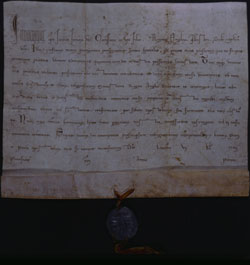 |
 |
 |
 |
 |
 |
 |
|
(8/8)
The General Chapter discouraged lay visitors to Cistercian abbeys and forbade their attendance at the Canonical Hours, Mass and Communion, but it was officially recognised that on great occasions such as Palm Sunday, Ash Wednesday, Easter and the Purification of Mary (2 February), guests might be present. There were initially strict rulings against the admittance of women, but by the mid-twelfth century external pressure forced the General Chapter to compromise and it was conceded that all women, except those who were breastfeeding, might enter the church on the day of its dedication or within the octave. In 1401 the abbot of Fountains, in his capacity as Father Abbot, notified the abbot of Kirkstall of a papal receipt permitting women to enter the church at Kirkstall on those days when access was permitted to men, although they were strictly prohibited from entering any other buildings in the precinct.(5)
It is not clear where visitors were accommodated when they attended the services; they may have taken their place in the area beyond the lay-brothers’ choir, the furthest point from the High Altar, or in the North Galilee, a porch that extended some fifty metres northwards from the north door of the church. Whilst it was not uncommon to have a galilee situated to the west of the church, as at Byland, Fountains and Rievaulx, its position to the north of the church of Kirkstall and the use of the north door as a major point of access, is unusual; this is probably an original feature.
|
||||

